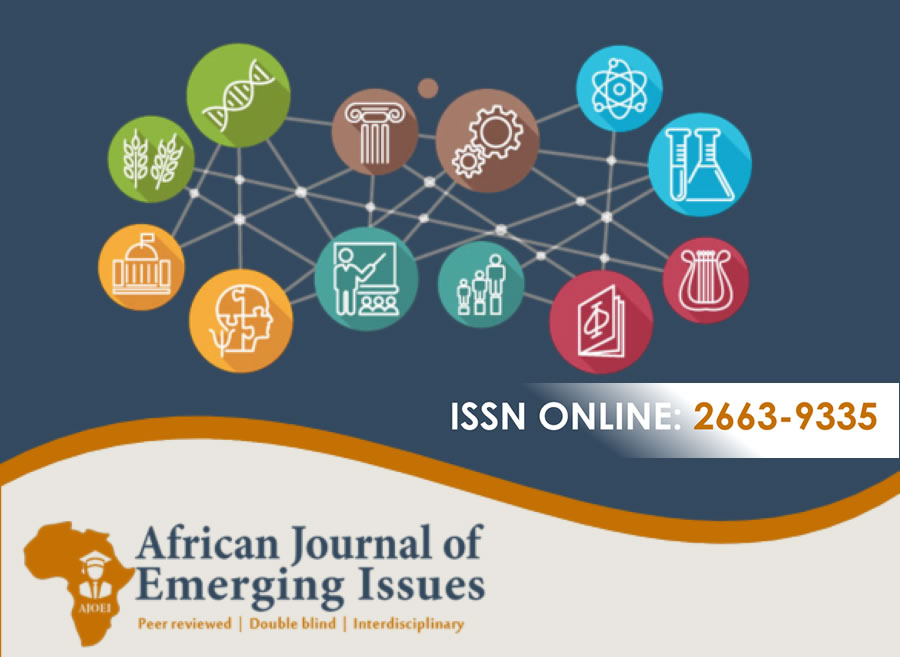EFFECTIVENESS OF THE PLANTING FOR FOOD AND JOBS PROGRAMME ON FOOD SECURITY IN KASSENA NANKANA MUNICIPAL
Abstract
Purpose of the Study: To explore the effectiveness of the Planting for Food and Jobs (PFJ) initiative on food security in Kassena Nankana Municipal, introduced by Ghana in 2017 to ensure self-sufficiency, provide employment opportunities, and raise awareness of the importance of farming.
Statement of the Problem: The PFJ initiative was launched to address significant challenges in Ghana’s agricultural sector, aiming to boost food security and reduce poverty. Despite its benefits, the PFJ program faces several implementation challenges, such as uneven distribution of input points, inadequate seeds and fertilizers due to smuggling, erratic rainfall, political interference, and logistical issues.
Methodology: The study adopted a descriptive research design using a mixed-methods approach. Quantitative and qualitative data were collected through questionnaires, interviews, and focus group discussions. Simple random sampling selected farmers, while purposive sampling targeted key informants. Data were analyzed using SPSS v20 and presented through percentages, charts, and tables.
Findings: The study revealed that farmers are somewhat aware of the PFJ packages, with significant participation from all major stakeholders. The number of Agricultural Extension Agents, including NABCOs, increased significantly. The municipality became food-secure due to the PFJ program, which also significantly improved food security, reduced unemployment, and alleviated poverty. However, challenges such as uneven input distribution, inadequate seeds and fertilizers, erratic rainfall, political interference, and logistical issues were identified as impediments to the program's success.
Recommendations: To address these challenges, a holistic and multidimensional approach is needed. This includes ensuring even distribution of input points, minimizing political interference, fostering an evaluation culture, increasing investments in the agricultural sector, enhancing inter-sector cooperation and collaboration, improving access to affordable financing for Farmer-Based Organizations (FBOs), and developing a robust administrative statistics system to track progress and outcomes effectively
Keywords: Planting for Food and Jobs, Exploration, Effectiveness, Food Security, Agricultural Extension Agents.
References
Ali, A., & Khan, M. (2013). Livestock ownership in ensuring rural household food security in Pakistan. Journal of Animal and Plant Sciences, 23(1), 313–318.
Arene, C. J., & Anyaeji, R. C. (2010). Determinants of food security among households in Nsukka Metropolis of Enugu State, Nigeria. Pakistan Journal of Social Sciences, 30(1), 9–16.
Asghar, Z., & Muhammad, A. (2013). Socio-economic determinants of household food insecurity in Pakistan. Unpublished manuscript.
Doppler, W. (2002). Farming and rural systems approaches. Published lecture material, University of Hohenheim.
Ene-Obong, H., Schönfeldt, H. C., Campaore, E., Kimani, A., Mwaisaka, R., Vincent, A., & Charrondiere, U. R. (2019). Importance and use of reliable food composition data generation by nutrition/dietetic professionals towards solving Africa's nutrition problem: Constraints and the role of FAO/INFOODS/AFROFOODS and other stakeholders in future initiatives. Proceedings of the Nutrition Society, 78(4), 496–505. https://doi.org/10.1017/S0029665119001113
Farrukh, M. U., Bashir, M. K., & Rola-Rubzen, F. (2020). Exploring the sustainable food security approach about agricultural and multi-sectoral interventions: A review of cross-disciplinary perspectives. Geoforum, 108, 23–27. https://doi.org/10.1016/j.geoforum.2019.11.015
Food and Agriculture Organization. (2015). Country fact sheets on food and agriculture policy trends. Accra: Food and Agriculture Policy Development Analysis.
Frongillo, E. A., Jr. (1999). Validation of measures of food insecurity and hunger. The Journal of Nutrition, 129(2), 506–509. https://doi.org/10.1093/jn/129.2.506
Ghana Statistical Service. (2014). 2010 population and housing census: District analytical report – Kassena Nankana Municipal. Accra: Ghana Statistical Service.
Issahaku, G., & Abdulai, A. (2020). Can farm households improve food and nutrition security through adoption of climate‐smart practices? Empirical evidence from Northern Ghana. Applied Economic Perspectives and Policy, 42(3), 559–579. https://doi.org/10.1002/aepp.13061
Institute of Statistical, Social and Economic Research (ISSER). (2017). The state of the Ghanaian economy in 2015. Legon: University of Ghana.
Kassena Nankana Municipal Assembly. (2018). Medium-term development plan (2018–2021). Navrongo: Kassena Nankana Municipal Assembly.
Ministry of Finance and Economic Planning. (2017). The budget statement and economic policy of the Government of Ghana for the 2017 financial year. Accra: Government of Ghana.
Ministry of Food and Agriculture. (2017). Planting for food and jobs concept: A program to stimulate rapid growth of the Ghanaian agricultural sector. Accra: Ministry of Food and Agriculture.
Ministry of Food and Agriculture. (2016). Statistics, research, and information directorate (SRID) annual report. Accra: Ministry of Food and Agriculture.
Ministry of Food and Agriculture. (2015). Statistical, research, and information directorate (SRID) annual report. Accra: Ministry of Food and Agriculture.
Ministry of Food and Agriculture. (2007). Statistics, research, and information directorate (SRID) report. Accra: Ministry of Food and Agriculture.
Riely, F., Mock, N., Cogill, B., Bailey, L., & Kenefick, E. (1999). Food security indicators and framework for use in the monitoring and evaluation of food aid programs. Washington, DC: Nutrition Technical Assistance Project (FANTA).
Rukuni, M. (2002). Africa: Addressing growing threats to food security. The Journal of Nutrition, 132(11), 3443S–3448S. https://doi.org/10.1093/jn/132.11.3443S
Rose, D., Gundersen, C., & Oliveira, V. (1998). Socio-economic determinants of food insecurity in the United States: Evidence from the SIPP and CSFII datasets (No. 1488-2016-124599). United States Department of Agriculture.
Zhou, D., Shah, T., Ali, S., Ahmad, W., Din, I. U., & Ilyas, A. (2019). Factors affecting household food security in the rural northern hinterland of Pakistan. Journal of the Saudi Society of Agricultural Sciences, 18(2), 201–210. https://doi.org/10.1016/j.jssas.2017.05.003





